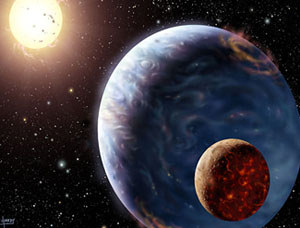Earth-sized moons may orbit around ‘hot Jupiters’
 Sydney, September 12 : In a new study, scientists have determined that giant gas planets like Jupiter, which orbit close to their parent star, could harbour moons the size of Earth.
Sydney, September 12 : In a new study, scientists have determined that giant gas planets like Jupiter, which orbit close to their parent star, could harbour moons the size of Earth.
According to a report by ABC News, the study was led by graduate student Tim Cassidy from the University of Virginia in Charlottesville, US.
Hot Jupiters are giant gas exoplanets with a mass greater than Jupiter’s and orbit close to their parent star - sometimes closer than Mercury’s orbit around our own Sun.
Because their large size makes them easier to spot, they represent most of the 350-plus exoplanets detected to date.
Previous theories have suggested that satellites of these systems would be ejected into space due to the gravitational pull of the giant planet and its host star.
Others have suggested that their orbits would decay early in their solar system’s evolution, sending the satellites spiralling into the gas giant.
But, Cassidy and colleagues said their mathematical model shows that satellites with a wide range of orbits could remain in stable orbits for thousands of millions of years, even if these hypothetical moons were as large as the Earth.
“We have shown that orbital decay due to tides raised in the planet by the satellite may be much less efficient that previously thought,” they said.
“Consequently, even Earth-size satellites may be stable around hot Jupiters over billion year timescales,” they added.
Most large exoplanets are detected using the transit method, which measures the drop in light received from a star as the planet passes in front of it.
No exoplanet satellites have yet been found, but Earth-sized satellites should be spotted by NASA’s Kepler space telescope and the French CNES COROT space telescope.
According to Professor Chris Tinney of the University of New South Wales in Sydney, if satellites around hot Jupiters were detected, this result would suggest that satellites are ubiquitous around gas giant planets orbiting other stars.
But, such worlds would hardly be habitable.
“Even if they started out rocky, tidal heating will keep such planets essentially molten - and much more volcanically active than Jupiter’s moon Io,” said Tinney. (ANI)
